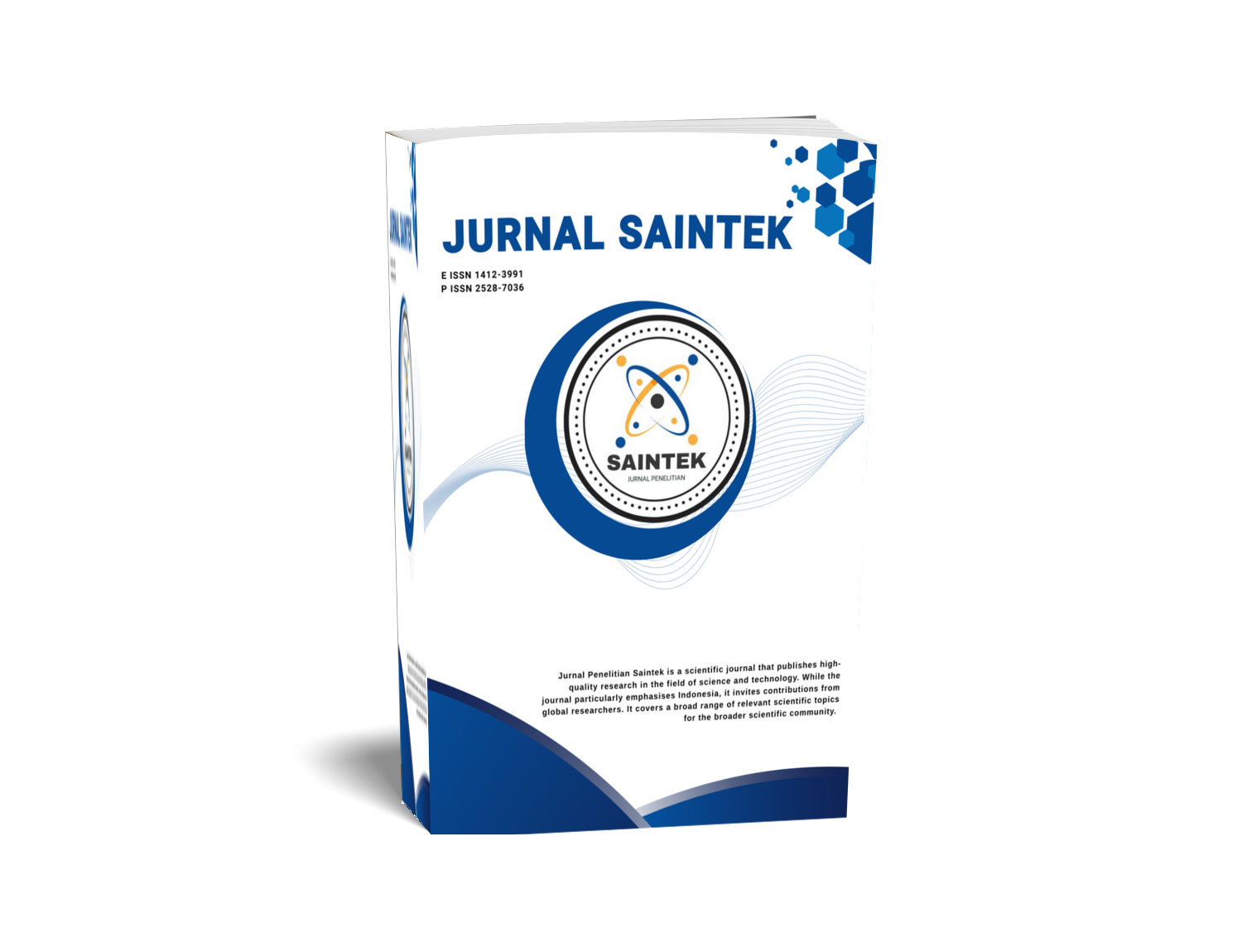ANTIBACTERIAL ACTIVITY OF ALOE VERA LEAF INFUSE [Aloe barbadensis Miller]
DOI:
https://doi.org/10.21831/jps.v21i2.13942Keywords:
Antibacterial, aloe vera leaf infuse, agar well diffusionAbstract
The aim of this studi is to examine the antibacterial activity of aloe vera leaf infuse (Aloe barbadensis Miller) against human pathogens such as Pseudomonas aeroginosa, Salmonella typhi, Staphylococcus aureus, dan Streptococcus pneumonia. Antibacterial activity test of 20, 40, and 60% aloe vera leaf infuse was using agar well diffusion method. The antibacterial activity is indicated by the formation of a clear zone around the wells. All the concentration of aloe vera leaf infuse (Aloe barbadensis Miller) showed signiï¬ cant antibacterial activity against Pseudomonas aeroginosa, Salmonella typhi, Staphylococcus aureus, but did not show antibacterial activity against Streptococcus pneumonia. Aloe vera leaves infuse at a concentration of 60% can inhibit the growth of Pseudomonas aeroginosa indicated by the formation of a clear zone (16.5 mm), the bacteria Salmonella typhi (34 mm), and Staphylococcus aureus (15 mm). The research recommended aloe vera leaf would be suitable for use as antibacterial agent of disease caused by Pseudomonas aeroginosa, Salmonella typhi, and Staphylococcus aureus.
References
Agarry, O. O., Olayeye, M. T., BelloMichael, C. O. (2005). Comparative antimicrobial activities of aloe vera gel and leaf. Biotechnology, 4(12), 14-34.
Ariane, I. (2009). Pengaruh ekstrak lidah buaya (aloe vera) terhadap pertumbuhan pseudomonas aeruginosa pada pasien osteomielitis Bangsal Cempaka Rumah Sakit Ortopedi Prof. Dr. R. Soeharso Surakarta Invitro. (Skripsi). FK UNS, Surakarta.
Ariyanti, N. K., Darmayasa, I. B. G., & Sudirga, S. K. (2012). Daya hambat kulit daun lidah buaya (aloe babadensis miller terhadap pertumbuhan bakteri staphylococcus aureus ATCC 25923 dan echerichia colli ATTC 25922. Jurnal Biologi, 16(1), 1-4.
Begum, H., Shimmi, S. .C, Rowshan, M. M, Khanom, S. (2016). Effect of ethanolic extract of aloe vera gel on certain common clinical pathogens. Borneo Journal of Medical Sciences, 11(2), 19-25. Dari http://jurcon.ums. edu.my/ojums/index.php/bjms/article/ viewFile/574/395.
Brooks, G. F., Carroll, K. C., Butel, J. S., & Morse, S. A. (2007). Jawetz, Melnick & Adelberg's medical microbiology (24 ed.). United Stated of America: McGraw-Hill.th
Brooks, G. F., Carroll, K. C., Butel, J. S., & Morse, S. A. (2012). Jawetz, Melnick, & Adelbreg. Mikrobiologi kedokteran (ed. 25). Jakarta: EGC.
Cowan, M. M. (1999). Plant products as antimicrobial agents. Departement of Microbiology, Miami University, Oxford, Ohio.
Dwidjoseputro, D. (1994). Dasar-dasar mikrobiologi. Jakarta: Djambatan.
Furnawanthi, I. (2007). Khasiat dan manfaat lidah buaya si tanaman ajaib. Jakarta: Agro Media Pustaka.
Harborne, J. B. (1996). Metode ï¬ tokimia: Penuntun cara modern menganalisa tumbuhan. (Terj.: Kosasih Padmawinata & Iwang Soediro). Bandung: ITB.
Harmita, & Radji, M. (2008). Buku ajar analisis hayati. Jakarta: EGC.
Kedarnath, Kamble, K. M, Chimkod, V. B., & Patil, C. S. (2013). Antimicrobial activity of aloe vera leaf extract. International Journal of Applied Biology and Pharmaceutical Technology, 4(4), 286290. Dari https://www.researchgate.net/ publication/257948745.
Nejatzadeh-Barandozi, F. (2013). Antibacterial activities and antioxidant capacity of aloe vera. Organic and Medicinal Chemistry Letters, 3(1), 5. Dari https://www.ncbi.nlm.nih.gov/ pmc/articles/PMC3729540/pdf/21912858-3-5.pdf.
Lawrence, R., Tripathi, P., & Jeyakumar, E. (2009). Isolation, puriï¬ cation and evaluation of antibacterial agents from aloe vera. Braz. J. Microbiol, 40(4). Dari http://www.scielo.br/scielo. php?script=sci_arttext&pid=S151783822009000400023.
Newall, C. A., Anderson, L. A., & Phillipson, J. D. (1996). Herbal medicines. A guide for health-care professionals. London:
The Pharmaceutical Press. Pelczar, M. J., & Chan, E. C. S. (1988). Dasar-dasar mikrobiologi. (Terj.: Ratna Siri Hadioetomo dkk.). Jakarta: UI Press.
Purbaya, J. R. (2003). Mengenal dan memanfaatkan khasiat aloe vera. Bandung: C.V. Pionerjaya.
Radji, M. (2011). Mikrobilogi. Buku kedokteran. Jakarta: EGC.
Saeed, M. A., Ah ma d , I . , Yaqub, U., Akbar, S., Waheed, A., Saleem, M., & Din, N-u. (2003). Aloe vera: A plant of vital signiï¬ cance. Sci. Vision, 9(1-2), 1-13.
Schelegel, H. G. (1994). Mikrobiologi umum (Edisi ke-6). Yogyakarta: Gajah Mada Univerty Press.
Syukur, C., & Hernani. (2006). Budidaya tanaman obat komersial. Jakarta: Penebar Swadaya.
Velasco, E. A., Verheul, A. F. M., Verhoef, J., & Snippe, H. (1995). Streptococcus pneumoniae: Virulence factors, pathogenesis, and vaccines. Microbiology, 59(4), 591-603.
Voigt, R. (1994). Buku pelajaran teknologi farmasi. (Terj.: Nurono). Yogyakarta, Gajah Mada University Press.
Wu, Y. W., Ouyang, J., Xiao, X. H., Gao, W. Y., & Liu, Y. (2006). Antimicrobial properties and toxicity of anthraquinones by microcalorimetric bioassay. Chinese J. Chem, 24, 45-50.
Published
How to Cite
Issue
Section
Citation Check
License
Who Can Submit?
Any individual may submit an original manuscript for consideration for publication in Jurnal Penelitian Saintek as long as they hold the copyright to the work or are authorized by the copyright owner(s) to submit it. Authors retain initial ownership of the copyrights to their works prior to publication, except in cases where, as a condition of employment, they have agreed to transfer copyright to their employer.
User Rights
Jurnal Penelitian Saintek is an Open Access journal. Users are granted the right to read, download, copy, distribute, print, search, or link to the full texts of articles, provided they comply with the conditions of the Creative Commons Attribution-ShareAlike License 4.0 (CC BY-SA 4.0).
https://creativecommons.org/licenses/by-sa/4.0/
Author Rights
Authors retains copyrights.
Jurnal Penelitian Saintek by http://journal.uny.ac.id/index.php/saintek is licensed under a Creative Commons Attribution-ShareAlike 4.0 International License.









